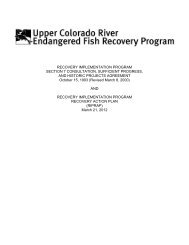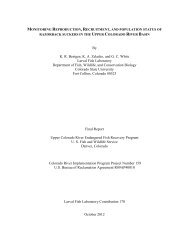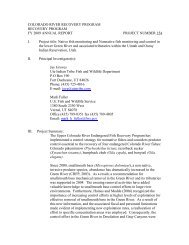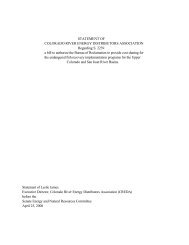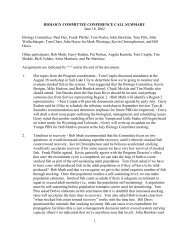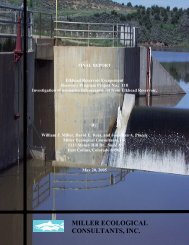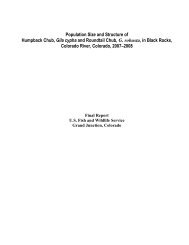27During 1986-1988, 17 adult Colorado pikeminnow were captured in the 15-Mile Reach duringApril-June and radio-tagged. The fish exhibited a diversity <strong>of</strong> localized movements throughoutthe Grand Valley but spent a major part <strong>of</strong> their time in the 15-Mile Reach. Two remained in thereach throughout the estimated spawning period (Osmundson and Kaeding 1989).In a study by McAda and Kaeding (1991), a suspected prespawning aggregation <strong>of</strong> adultColorado pikeminnow was observed in mid-July <strong>of</strong> 1982 at river mile 178.3 in the 15-Mile Reach.In the first observation, three radio-tagged fish were tracked to one riverine pool area, and nineadults at or near spawning condition were then captured there after limited net sampling ef<strong>for</strong>ts.The aggregation occurred a few days after mean daily water temperature had reached 20 o C andduring a time when run<strong>of</strong>f flows were dropping <strong>of</strong>f sharply. A second aggregation was noted atriver mile 175.3, 12 days after the initial observation. Drifting trammel nets through an areaoccupied by two fish equipped with transmitters yielded an additional male Colorado pikeminnowin spawning condition. During this same time period, an adult female was captured near river mile175 that weighed nearly 1 pound more than when previously captured a month earlier, suggestingthe development <strong>of</strong> spawning (gravid) condition. Two Colorado pikeminnow larvae weresubsequently collected within the 15-Mile Reach.During 4 years (1982-1985) <strong>of</strong> larval sampling throughout the Grand Valley, 100 larvalpikeminnow were collected with fine-mesh hand nets from the two Colorado River reachesimmediately upstream and downstream <strong>of</strong> its confluence with the Gunnison River (McAda andKaeding 1991). Although the sampling ef<strong>for</strong>t was similar in the two river reaches, 98 percent <strong>of</strong>the larval captures occurred downstream <strong>of</strong> the Gunnison River confluence. Only two (2 percent)<strong>of</strong> the larvae were collected from the upstream reach. These observations may indicate that mostfish were spawned in the downstream reach or that the larvae were deposited in the upstreamreach and drifted downstream to the area where most <strong>of</strong> the captures were recorded. In 1995,drift nets set in the lower portion <strong>of</strong> the 15-Mile Reach captured 3 Colorado pikeminnow larvae(Anderson 1998).No postlarval young-<strong>of</strong>-year Colorado pikeminnow greater than 25 mm total length werecollected from above the Gunnison River confluence in fall collections from 1986-1994; however,one yearling-sized individual was captured there in 1986 (Osmundson and Burnham 1998). Atotal <strong>of</strong> 122 Colorado pikeminnow were collected in the 31-Mile Reach downstream <strong>of</strong> theconfluence <strong>of</strong> the Gunnison River during 1982-1996 (McAda and Ryel 1999). The 1982-1984catch rate <strong>of</strong> young-<strong>of</strong>-year Colorado pikeminnow in the 10-Mile Reach immediately downstream<strong>of</strong> the confluence <strong>of</strong> the Gunnison River (river miles 160-170) warranted classification <strong>of</strong> thisreach as a "Young-<strong>of</strong>-Year Nursery Area" by the Basin Biology Subcommittee (USFWS 1984).Catch rates <strong>of</strong> adult (> 500 mm long) Colorado pikeminnow in the 15- and 18-Mile Reaches <strong>of</strong>the Grand Valley are significantly higher than in any other portion <strong>of</strong> the Colorado River(Figure 1). In the 15-Mile Reach, adults are most abundant during spring in a 1.3-mile segmentbetween river miles 174.4 and 175.7, particularly in two gravel-pit ponds that were accessible
during high flows. Some <strong>of</strong> the pikeminnow captured from one pond in 1986 were welltuberculated by June 3, when nearby river temperatures were only 10-13 o C (L. Kaeding pers.com.). It has been hypothesized by some investigators that additional thermal units, above thoseprovided in the mainstream, are important in increasing annual growth rates and perhaps ingonadal maturation. If this is true, then access to these sheltered <strong>of</strong>f-channel pools may be veryimportant in increasing rates <strong>of</strong> survival and successful spawning in the upper reaches <strong>of</strong> theColorado River. Historically, bottomlands that routinely flooded during the spring run<strong>of</strong>f periodwould have provided these warm productive habitats; in recent years, flooded gravel pits mayprovide the only comparable habitat.Although the river downstream <strong>of</strong> the Grand Valley also supports adult Colorado pikeminnow,the primary importance <strong>of</strong> these downstream reaches is in providing nursery areas <strong>for</strong> larvae andrearing areas <strong>for</strong> juveniles. Concentrations <strong>of</strong> larvae and young-<strong>of</strong>-year occur in backwaters in the65-mile, low-gradient reach between Moab, Utah, and the confluence with the Green River(McAda et al. 1994). These backwaters are especially important during the Coloradopikeminnow’s critical first year <strong>of</strong> life. Juveniles dwell in these downstream reaches until they are5 or more years old. Then many begin extensive upstream migrations seeking habitats moresuited to needs <strong>of</strong> subadults and adults (Osmundson et al. 1998). The entire river, from theconfluence with the Green River upstream to Palisade, Colorado, provides important habitat <strong>for</strong>sub- and young adults.Razorback SuckerSpecies/Critical Habitat DescriptionThe razorback sucker, an endemic species unique to the Colorado River Basin, was historicallyabundant and widely distributed within warmwater reaches throughout the Colorado River Basin.The razorback sucker is the only sucker with an abrupt sharp-edged dorsal keel behind its head.It has a large fleshy subterminal mouth that is typical <strong>of</strong> most suckers. Adults <strong>of</strong>ten exceed 3 kg(6 pounds) in weight and 600 mm (2 feet) in length.Historically, razorback suckers were found in the mainstem Colorado River and major tributariesin Arizona, Cali<strong>for</strong>nia, Colorado, Nevada, New Mexico, Utah, Wyoming, and in Mexico (Ellis1914; Minckley 1983). Bestgen (1990) reported that this species was once so numerous that itwas commonly used as food by early settlers and, further, that commercially marketable quantitieswere caught in Arizona as recently as 1949. In the Upper Basin, razorback suckers were reportedin the Green River to be very abundant near Green River, Utah, in the late 1800's (Jordan 1891).An account in Osmundson and Kaeding (1989) reported that residents living along the ColoradoRiver near Clifton, Colorado, observed several thousand razorback suckers during spring run<strong>of</strong>f inthe 1930's and early 1940's. In the San Juan River drainage, Platania and Young (1989) relayedhistorical accounts <strong>of</strong> razorback suckers ascending the Animas River to Durango, Colorado,around the turn <strong>of</strong> the century.28
- Page 1 and 2: FINAL PROGRAMMATIC BIOLOGICAL OPINI
- Page 3 and 4: INCIDENTAL TAKE ...................
- Page 5 and 6: 2" Reclamation’s portion of 120,0
- Page 7 and 8: On January 21-22, 1988, the Secreta
- Page 9 and 10: funding component of the Recovery P
- Page 11 and 12: 81. Habitat Protection ElementGener
- Page 13 and 14: Also, the Service and the Colorado
- Page 15 and 16: Table 1. The estimated benefits in
- Page 17 and 18: through recovery efforts that will
- Page 19 and 20: native fishes. Also, some species o
- Page 21 and 22: “new” depletions. This would in
- Page 23 and 24: Based on early fish collection reco
- Page 25 and 26: infrequent pulsed recruitment make
- Page 27 and 28: Area, in the Loma to Black Rocks re
- Page 29: 26Figure 1. Distribution of adult C
- Page 33 and 34: In the Upper Basin, above Glen Cany
- Page 35 and 36: 32Populations DynamicsThere are no
- Page 37 and 38: in low velocity shorelines and back
- Page 39 and 40: 36IMPORTANCE OF THE 15-MILE REACHTh
- Page 41 and 42: occur in the 15-Mile Reach). Provid
- Page 43 and 44: Applying the above regulations, the
- Page 45 and 46: in a river basin. While the model i
- Page 47 and 48: 44Factors Affecting Species Environ
- Page 49 and 50: 46To determine conditions with wate
- Page 51 and 52: 48140001200010000CFS800060004000200
- Page 53 and 54: 50CFS240002200020000180001600014000
- Page 55 and 56: 52CFS280002600024000220002000018000
- Page 57 and 58: Release and protection of surplus H
- Page 59 and 60: 56CFS500045004000350030002500200015
- Page 61 and 62: The formation of a variety of chann
- Page 63 and 64: options will be determined through
- Page 65 and 66: Passage at the Price-Stubb Diversio
- Page 67 and 68: species. Recent population estimate
- Page 69 and 70: the endangered fishes. Ongoing Reco
- Page 71 and 72: 68the Colorado pikeminnow, razorbac
- Page 73 and 74: 70There are no current population e
- Page 75 and 76: additional reasonable and prudent m
- Page 77 and 78: The Recovery Action Plan is an adap
- Page 79 and 80: 76actions have all been completed a
- Page 81 and 82:
78LITERATURE CITEDAbbott, C. C. 186
- Page 83 and 84:
80the Upper Colorado River Basin, P
- Page 85 and 86:
Kaeding, L. R., and D. B. Osmundson
- Page 87 and 88:
Minckley, W. L. 1983. Status of the
- Page 89 and 90:
Pitlick, J., and M. Van Steeter. 19
- Page 91 and 92:
Tyus, H. M., B. D. Burdick, R. A. V
- Page 93:
Wick, E. J. 1997. Physical processe



